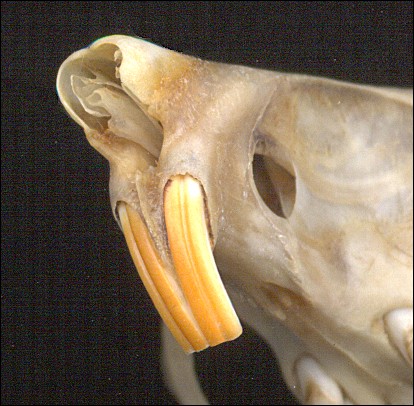

Man, those teeth are really groovy. Well, perhaps the terminology dates me, but I'm talking about upper incisor teeth. No, not ours, but of a whole bunch of critters belonging to the rodent and rabbit groups. Look into the mouth of one of our desert Kangaroo rats, and you might think it has four upper front teeth—but look again closely. Those four teeth are really two, each with a groove running down the front. Lots of rodents and all rabbits and hares have grooved front teeth, but why? We can only guess.
Generally, a cylinder has more strength than a flat piece of the same
material and weight. Possibly semi-dividing the front surface gives additional
mechanical strength to these gnawing teeth. Or perhaps this is a way increase the
amount of the heavy, hard enamel on the front surface of the tooth, thus deceasing the
rate of wear. Or maybe the notch produced at the gnawing end of the tooth makes chewing
more efficient. Or just maybe we need a student to study this. Any volunteers?

Contributor: Arthur H. Harris, Laboratory for Environmental Biology, Centennial Museum, University of Texas at El Paso.
Desert Diary is a joint production of the Centennial Museum and KTEP National Public Radio at the University of Texas at El Paso.

Upper incisors of a Banner-tail Kangaroo Rat (Dipodomys spectabilis). Each of
the two incisors has a groove running lengthwise. Laboratory for Environmental Biology
specimen, scanned.![]()